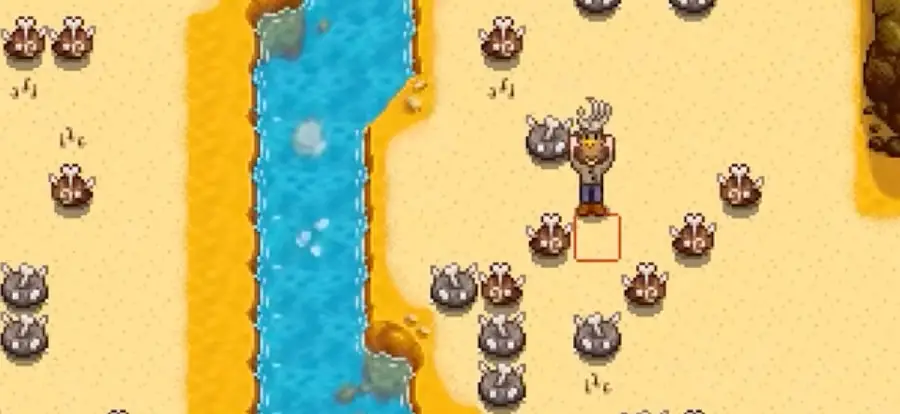Stardew Valley Desert Dinosaur Bones: Complete Guide to Fossilized Skulls
Hello, friends! In this tutorial, we will discuss how to obtain various fossils and prehistoric bones in Stardew Valley, including 7 types of prehistoric bones and 4 types of fossils: Prehistoric Scapula, Prehistoric Tibia, Prehistoric Skull, Hand Bones, Prehistoric Ribs, Prehistoric Vertebra, and Tail Bones.

Ammonite Fossil, Amphibian Fossil, Palm Fossil, and Trilobite are 11 types that need to be donated to the Museum, and cannot be obtained from Artifact Troves, which is why many players’ collection progress gets stuck on bones. There are four ways to obtain them: Ginger Island dig site, digging Artifact Spots, fishing treasure chests, and killing monsters.
Ginger Island Dig Site
The dig site is a treasure trove, as the probability of obtaining any bone from Bone Nodes is 0.8%. With good luck or enough time, you can complete all bone donations. However, Bone Nodes refresh quite slowly, and you may only find a few per day, which can be frustrating. For beginners, it may take three to four years to accumulate all the bones, but it is possible by waiting for Bone Nodes to appear.
Bone Nodes are predetermined daily, so you can use save and load to refresh. Dig once, remember which piece yields the desired item, reload the save, and only dig that piece. The rest can be dug the next day. This method can help you collect all the bones in a relatively short amount of time, but it may still take a long time if you’re unlucky.
Digging Artifact Spots
Artifact Spots can yield all types of bones. In earlier versions of the game, without Ginger Island and Artifact Troves, most artifacts had to be obtained by digging worms. Worms refresh slowly, so most players would dig them when they come across them. As a result, the farm and bus stop areas would be dug more frequently than other areas, but each map has a fixed set of bones that can be obtained.
To understand the probability of obtaining an artifact from worms, let’s take the Prehistoric Scapula as an example. The probability in the town is 0.7%, while Marnie’s Ranch ranges from 3% to 6%. The probability range is due to the different items that worms produce in different seasons, with spring including rice shoots, and winter having Snow Yams and Winter Roots. Winter has a 3% chance, while summer and autumn have a 6% chance, and spring is slightly lower at around 5.6%.
However, the number of worms is positively correlated with the area that can generate worms. For Marnie’s Ranch, more worms are generated in winter, making it easier to find artifacts during that season. In summary, the probabilities are not very high, and it’s normal for players to not find certain artifacts for one or two months solely relying on luck. Worms can also be refreshed using save and load, so if you’re missing only one or two types of bones, digging worms might be faster than digging Bone Nodes.
Fishing Treasure Chests
Of the 42 artifacts in the game, fishing can yield 22 types. For the 11 types of bones, only 3 can be obtained from treasure chests: Tail Bones, Ammonite Fossil, and Amphibian Fossil. These three have the highest probability among the artifacts in the chests, ranging from 3.1% to 3.4%. If you fish frequently, you should obtain these three eventually. If you’re missing these three types, you can use Magnet Bait, the Treasure Hunter Tackle, and the Pirate skill to increase the treasure chest chance to 50%. It should take about one or two days of fishing to obtain them.
For other artifacts, the probabilities are between 0.7% and 0.8%, so it’s not recommended to rely on fishing to obtain them, especially for artifacts that can be obtained from Artifact Troves. Comparatively, opening Artifact Troves is much more efficient.
Killing Monsters
Dinosaurs are the first monsters that come to mind when discussing bone drops. While it may seem like dinosaurs drop many bones, they only drop three types: Prehistoric Tibia, Prehistoric Ribs, and Prehistoric Vertebra, with a drop rate of 30% for each, and a 10% chance for a Dinosaur Egg. There are plenty of dinosaurs, so you should have no problem obtaining these three types.
Skeletons found in the Mines between levels 70 and 80 drop Prehistoric Scapula with a 0.5% probability. Although this rate may seem low, there are many Skeletons in that area, and using Monster Musk and a Burglar’s Ring can help you find the Scapula within a day. Haunted Skull drop Prehistoric Skulls and Hand Bones with a 1.3% chance. Although the drop rate is higher than the Scapula, Haunted Skull can only be found in the Quarry Mine and dungeon levels of the Mines. Quarry Mine refreshes once per day and cannot be farmed repeatedly, and dungeon levels do not appear on elevator floors.
If a dungeon level is generated on a floor ending in 1 and you are missing Prehistoric Skulls and Hand Bones, you may consider farming it. Tail Bones are the only prehistoric bones that cannot be dropped by monsters but can be found by digging in the Mines and Skull Cavern. If you frequently mine, you should not have an issue finding them.
That’s it for obtaining all types of bones in Stardew Valley! Which ones have caused you trouble in the past?